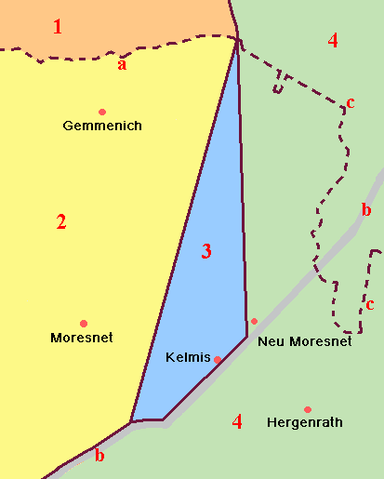
File:Moresnet.png

| |
This is a file from the Wikimedia Commons. Information from its description page there is shown below.
Commons is a freely licensed media file repository. You can help. |
Summary
| Description |
Česky: Schématická mapa Neutrálního Moresnetu a okolí.
Legenda: 1. cs:Nizozemí (od roku cs:1830)*, cs:provincie Limburg a. holandsko-belgická hranice (od roku cs:1843)* (*) Území (1) a (2) byla v letech cs:1815 – cs:1830 sjednocena jako cs:Spojené království nizozemské. V roce cs:1830 se Belgie odtrhla, zbytek původního království je od roku cs:1839 znám jako Holandsko. Hranice mezi oběma zeměmi byly formálně stanoveny v roce cs:1843. (#) V roce 1919, obdržela Belgie dvoujazyčný Moresnet a část německy a fracouzsky mluvících Východních kantonů jako kompenzaci škod, které utrpěla v 1. světové válce. Od té doby jsou všechna území (2), (3) a (4 západně od c) částí Belgie, s výjimkou krátkého období za 2. světové války, kdy byly Moresnet a Východní kantony obsazeny Německem.English: Schematic map of the location and surroundings of Neutral Moresnet.
Features: 1. The Netherlands (as of 1830)*, province of Limburg a. The Dutch-Belgian border (as of 1843)* (*) Territories (1) and (2) were joined from 1815 until 1830 as the united Kingdom of the Netherlands. In 1830, Belgium seceded, which was acknowledged by the Dutch in 1839. The border between the two countries was formally determined in 1843. (#) In 1919, Belgium received bilingual Moresnet and the part- Germanophone, part- Francophone East Cantons as compensation for damages incurred in World War I. Since then, all territories marked (2), (3) and (4 west of c) have been part of Belgium, except for a brief period in World War II when Germany (re-)annexed Moresnet and the East Cantons.Español: Mapa esquematizado de la ubicación y entorno de Moresnet Neutral.
Leyenda: 1. Países Bajos (fronteras de 1830)*, provincia de Limburg a. La frontera entre los Países Bajos y Bélgica ( 1843)* (*) Territorios (1) y (2) estuvieron unidos entre 1815 y 1830 como el Reino Unido de los Países Bajos. En 1830, Bélgica se separó, siendo reconocida la separación por holanda en 1839. La frontera entre los dos países fue formalmente determinada en 1843. (#) En 1919, Bélgica recibió el territorio bilingüe de Moresnet y los cantones del este, de habla en parte alemana y en parte francesa, como compensación por los daños sufridos durante la Primera Guerra Mundial. Desde entonces, los territorios marcados como (2), (3) y (4 oeste de c) han formado parte de Bélgica, excepto por un breve período durante la Segunda Guerra Mundial cuando Alemania re-anexó Moresnet y los cantones del este. The map was hand-drawn by Arjan de Weerd, who releases it into the public domain, provided he is credited whenever the image is (re)used.Français: Carte schématique du micro-état de Moresnet
1. Les Pays-Bas (frontière de 1830)*, Province de Limburg a. La frontière Pays-bas/Belgique (en 1843)* *Les territoires (1) et (2) appartenaient tout deux, de 1815 à 1830, au Royaume-Uni des Pays-Bas. En 1830, la Belgique prit son indépendance, qui fut reconnue par les Pays-Bas en 1839. La frontière entre les deux pays fut officialisée en 1843. #En 1919, La Belgique reçut les parties bilingue, germanophone et francophone de Moresnet à titre de compensation pour les dommages subis durant la Première Guerre mondiale. Depuis, les territoires (2), (3) et (4 à l'ouest de c) firent partie de la Belgique, sauf durant une courte période pendant la Seconde Guerre mondiale quand l'Allemagne réannexa Moresnet.Italiano: Carte schematica della micornazione di Moresnet
1. I Paesi Bassi (frontieri del 1830)*, Provincia del Limburgo a. Frontiera Paesi Bassi/Belgio (nel 1843)* *I territori (1) e (2) appartenevano entrambi dal 1815 al 1830, ai Paesi Bassi. Nel 1830, il Belgio divenne indipendente, ma fu riconsciuto indipendente dai Paesi Bassi solo nel 1839. La frontiera tra i due paesi fu fissata nel 1843. #Nel 1919, il Belgio ricevette Moresnet e il Cantone dell'Est come risarcimento dalla Germania alla fine della Prima Guerra Mondiale. I territori (2), (3) e (4 a ovest di c) hanno fatto da quella data sempre parte del Belgio, salvo dal 1940 al 1944 quando durante la Seconda Guerra mondiale furono annessi alla Germania Nazista. |
| Date | |
| Source |
This file is lacking source information. Transferred from en.wikipedia to Commons. ( Moresnet.png)Please edit this file's description and provide a source. |
| Author |
This file is lacking author information.
|
Licensing
| This file has been released into the public domain by the copyright holder, its copyright has expired, or it is ineligible for copyright. This applies worldwide. | |
Note: This tag is obsolete, and if you add it to an image after October 10 2008, it is liable to be tagged as {{ nsd}} or {{ npd}} as appropriate – this will result in deletion after 7 days.
العربية | български | česky | Deutsch | Deutsch (Sie-Form) | English | español | فارسی | français | हिन्दी | magyar | italiano | 日本語 | македонски | norsk nynorsk | norsk bokmål | occitan | polski | português | português do Brasil | русский | slovenčina | slovenščina | српски / srpski | 中文 | 中文(简体) | +/− |
File usage
Did you know...?
Schools Wikipedia has been carefully checked to give you the best learning experience. By supporting vulnerable children right through to adulthood, SOS Children's Villages makes a lasting difference to the lives of thousands of people. Education is a key part of our work, and our schools provide high-quality teaching to the children in our care. Sponsoring a child is a great way to help children who need your support.
